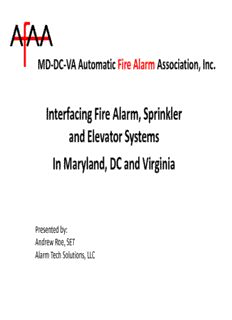
Elevator Controls, by Andy Roe, Alarm Tech Solutions PDF
Preview Elevator Controls, by Andy Roe, Alarm Tech Solutions
MD-DC-VA Automatic Fire Alarm Association, Inc. Interfacing Fire Alarm, Sprinkler and Elevator Systems In Maryland, DC and Virginia Presented by: Andrew Roe, SET Alarm Tech Solutions, LLC Scope: • The Purpose of Elevator Controls • History of Elevator Controls & Sprinklers • Elevator Recall and Power Shutdown • Relevant Codes • What our local AHJ’s are enforcing • Discussion of issues • Where we appear to be headed MD-DC-VA Automatic Fire Alarm Association 2 Purpose: • 1973 ASME A17.1b (supplement to the 1971 Code) • Purpose: – Prevent people from using elevators during a fire scenario – To Allow for Responding Firefighters to Account for all Elevators – Stage Equipment (Hose lines, air tanks, etc.) – Evacuate Occupants with Mobility Restrictions – Prevent Car from being called to the Fire Floor MD-DC-VA Automatic Fire Alarm Association 3 MD-DC-VA Automatic Fire Alarm Association 4 History - Controls: 1973 ASME A17.1b (supplement to the 1971 Code): • Identified Designated Level • Both Manual and Automatic Recall • Key Switch (only by firefighters) • Smoke Detectors in Lobbies • Travel of 25’ above or below designated level • 1981 introduced the “Alternate” Level MD-DC-VA Automatic Fire Alarm Association 5 History - Controls: • 1984 introduced “only” lobby and machine detectors were to initiate recall • A17.1 referred users to NFPA 72E, Automatic Fire Detectors • NFPA first mentions A17.1 requirements in 1987 edition of NFPA 72A, Installation, Maintenance and use of Local Protective Signaling Systems – “Elevator Recall for Firefighters’ Service” • 1993 edition of NFPA 72, National Fire Alarm Code addressed cases where there was no required building fire alarm system … “Elevator Recall and Supervisory Panel” MD-DC-VA Automatic Fire Alarm Association 6 History - Controls: • 1996 edition of NFPA 72 introduced “other” fire detection as being permissible if environment was not appropriate for a smoke detector. • A “third” control circuit was added to provide a warning of fire in the hoistway or elevator machine room • The 2000 A17.1 was “harmonized” with the Canadian B44 Elevator Safety Standard • NFPA 72 [2002] and A17.1 [2004] now both address new technology elevators … machine room-less elevators MD-DC-VA Automatic Fire Alarm Association 7 History - Controls: • First introduced in ASME A17.1 – 1984 • Purpose: • Remove Main-line Power prior to sprinkler activation • Prevent Elevator from Moving/Operating dangerously Note: the requirement does not include circuits for ventilation, in-car lights and communication, pit receptacles and lights, etc. MD-DC-VA Automatic Fire Alarm Association 8 History - Controls: • A17.1 applies to all new elevator installations • A17.3 (where adopted) applies to existing elevators • A17.3 re: Firefighters’ Service 3.11.3 Firefighters’ Service Elevators shall conform to the requirements of ASME/ANSI A17.1–1987 Rules 211.3 through 211.8 (see Appendix C) unless at the time of installation or alteration it was required to comply with a later edition of A17.1. MD-DC-VA Automatic Fire Alarm Association 9 History - Sprinklers: • Sprinklers in elevator machine rooms and hoistways have been recognized by the Safety Code for Elevators and Escalators, ASME A17.1 since the 1955 Edition. • The building codes at first did not require buildings to be sprinkled but encouraged their use by allowing “tradeoffs” (fire resistance ratings, distances to exits & area and height limitations) which reduced the cost of construction. • This “tradeoff” worked well and now the building codes require most buildings to be fully sprinkled. MD-DC-VA Automatic Fire Alarm Association 10
Description: